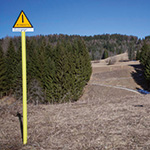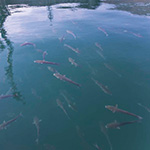SO1
Safeguarding the natural value of areas where it conducts new works is important to Snam. The Company carries out specialist field studies in order to acquire complete knowledge of the area. The results of these studies help to define and implement the most appropriate design choices for minimising the biodiversity impacts generated particularly in the construction phases, which are followed by environmental restoration and monitoring thereof, carried out in agreement and in cooperation with the entities in charge.
EN13
The objective of vegetation restoration, in particular reforestation, is not merely to reconstitute forest areas, but also to reconstitute the landscape in general and to revive the biological functionality of vegetated areas, understood especially in their role as habitats for fauna with specific biodiversity characteristics. Restoration and reforestation are followed by the execution of “plant care”, i.e. caring for and maintaining the bedded-out plants for a period of at least five years.
EN14
Monitoring projects concern the courses of some methane pipelines that interfere, albeit marginally, with natural local areas high in fauna and ecological value, and they are geared towards verification of the process of renaturalising areas affected by works, based on a comparison of conditions after restoration (“post-completion”) and the original conditions (“pre-completion”). Monitoring is normally performed for the most significant habitats identified in the design phase.
EN11
DISTANCE COVERED BY METHANE PIPELINES
IN NATURA 2000 NETWORKING SITES
| Download XLS (15 kB) |
|
|
2010 |
2011 |
2012 |
|
Km of network |
30.9 |
15.5 |
7.4 |
The main Natura 2000 areas affected by the course of methane pipelines in 2012 were:
- The basins of the old sugar refinery at Argelato and the floodplain of the Reno river (BO)
- The spring areas of Viarolo, the basins of the sugar refinery at Torrile, the floodplain of the Po (PR)
- The marshes at Arsago (VA)
- The marsh at Brabbia (VA)
ENVIRONMENTAL RESTORATION AND MONITORING (NETWORK KM)
| Download XLS (15 kB) |
|
|
2010 |
2011 |
2012 |
|
Restoration |
173 |
235 |
193 |
|
Reforestation |
25 |
43 |
6 |
|
Plant care |
151 |
151 |
158 |
|
Environmental monitoring |
883 |
1,065 |
830 |
MAJOR ENVIRONMENTAL MONITORING AND RESTORATION DURING THE YEAR
| Download XLS (17 kB) |
|
Entity |
Name |
Activities conducted |
|
Friuli-Venezia |
“Malborghetto - Bordano” methane pipeline |
Cooperation continued with the Region’s Parks Office on monitoring vegetation restoration along the course of the methane pipeline. In particular, in one section of the pipeline, in the Val Alba regional nature reserve, the ten-year fauna research and monitoring activities continued with the help of international experts. 2012 was the eighth year of fauna monitoring and the 10th and last year of vegetation and soil monitoring. |
|
Sicily Region |
“Bronte - Montalbano” methane pipeline |
Collaboration with the Sicily state forests agency continued, with the growing of native forest plants destined for reforestation projects along the course of the pipelines laid in the Nebrodi regional park. Periodic plant care was performed in 2012, along with the replacement of plants that had not taken root. The replacement plants will also be supplied by the Sicily state forests agency nurseries. Some soil bioengineering interventions were launched in autumn 2012 along the course of the methane pipeline within the Nebrodi Park, involving rooted and potted plants taken from the Regional Nursery. |
SUSTAINABLE PATHWAYS FOR THE PARCO DEI NEBRODI IN SICILY
In the second half of 2012, the book Sentieri Sostenibili, Parco dei Nebrodi (Sustainable Pathways, Parco dei Nebrodi) was published. This was an editorial project developed by Snam and produced by 24 ORE Cultura. The book, which was created with the collaboration of Parco dei Nebrodi, is the first in a series on corporate best practice relating to the application of naturalistic engineering techniques in particularly sensitive regions with complex ecosystems, such as parks and protected zones. The book tells the story of a constructive experience – the building of the Bronte-Montalbano Elicona methane pipeline, which crosses 15 km of Parco dei Nebrodi in Sicily – which provides a positive example of integration between sustainable economic development and protecting and creating value from the environment. This came about due to close collaboration built on dialogue and the sharing of objectives by the various protagonists in the initiative, including the park authority, the Environmental Observatory, experts from the University of Palermo and environmental associations.

The book presents the entire project, through a series of interviews, personal accounts, explorations and illustrations, from research through to creation and the restoration of the morphology and vegetation of the area crossed by the infrastructure, highlighting the geographical features and specific characteristics of the region’s landscape and native wildlife, and benefiting the stakeholders.
In the wake of the Snam Nebrodi experience, the University of Palermo delivered its first post-graduate training course on naturalist engineering. Today, this first training course has developed into a Master’s degree on environmental recovery and naturalistic engineering.
The book was unveiled at an International Conference on Natural Engineering and Regional Protection promoted by the Parco dei Nebrodi, the University of Palermo and AIPIN (Italian Association for Naturalistic Engineering) and sponsored, inter alia, by the Ministry of Environment and Federparchi. The conference addressed issues connected to defence of the soil and environmental recovery and requalification initiatives, with a particular focus on the Sicilian region. The project carried out by Snam was presented and the naturalistic engineering techniques used to build the methane pipelines were explained, with particular reference to the restoration of the environment and vegetation.
EN12

Safeguarding biodiversity
Vegetation restoration works began in autumn 2012 for the Somma Lombardo - Besnate DN 300 (12") - 24 bar methane pipeline, running for 5.8 km within the Lombardo Park in the Ticino Valley and, for around 1.5 km, within the Paludi di Arsago Site of Community Importance (SIC IT2010011) managed by the Park itself. The section of the Park that the pipeline runs through is characterised mainly by 4.9 km of broad-leaved forest, although it also has many allochthonous tree species. In agreement with the Park, a widespread plantation and reforestation project is under way. Around 12,500 plants and approximately 10,500 shrub species will be bedded out, with the vegetation restoration scheduled for completion in spring 2013.
The fauna survey continued in 2012 with a view to taking a census of protected amphibian species within the “Paludi di Arsago” SIC. The survey began in 2011 with the pre-works phase. Snam Rete Gas ensured the presence of expert herpetologists during works in order to identify any individual species present, prepare their transfer to suitable areas outside the excavation zone and record any useful data from their findings. During the works phase (monitoring still in progress), five species of amphibian were found in the areas surrounding the course of the pipeline, including a female Pelobates fuscus insubricus (a species of toad). This toad was found along the initial course of the pipeline, extracted, protected and moved to areas outside the works zone. In terms of the post-works monitoring, the fauna survey was extended to all wet areas conducive to amphibians, both within and on the periphery of the Paludi di Arsago SIC, in order to characterise in greater detail the main breeding sites of the Pelobates fuscus insubricus. These are delimited wet areas either not affected by the course of the Somma Lombardo – Besnate methane pipeline or marginally affected but sufficiently safeguarded with the help of the expert herpetologists, avoiding works during the breeding season and restoring natural features after the works are completed.
The batrachological survey (a fauna survey specific to amphibians) identified 28 amphibian breeding sites within the Paludi di Arsago SIC and its immediate surroundings: 15 of these were inside the SIC and 13 were outside its boundaries. These sites were in wet or aquatic areas.
The Pelobates fuscus was found in 14 sites, but evidence of breeding (larvae) was found in only 10 sites. Monitoring of the larvae development stages in relation to the hydroperiod, meanwhile, showed that the duration of inundation was sufficient for the completion of metamorphosis in only eight of these sites. The survey and characterisation of these sites has provided important scientific data for better understanding the local area and managing it more appropriately.


